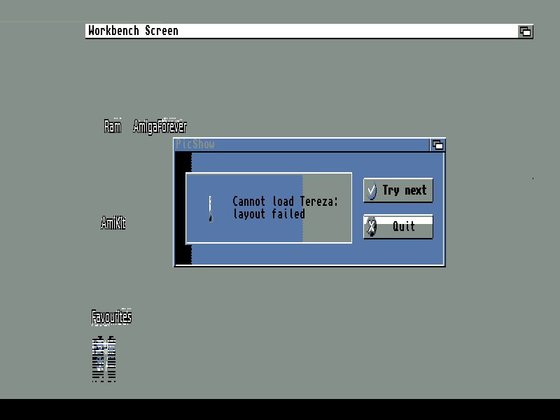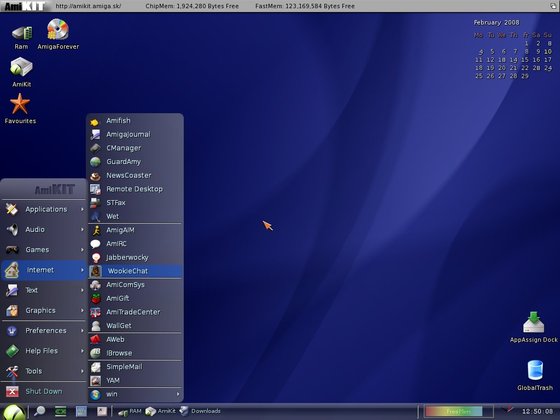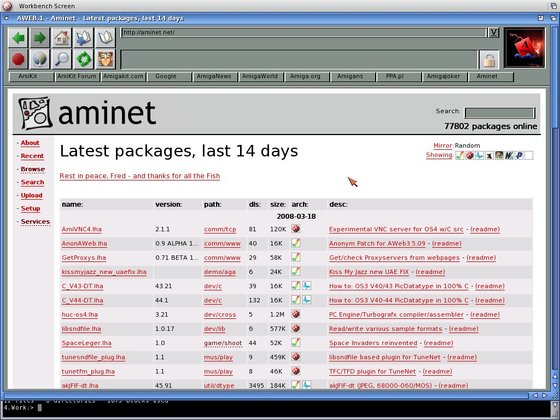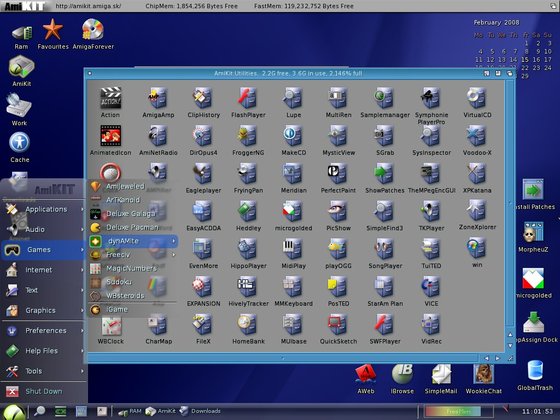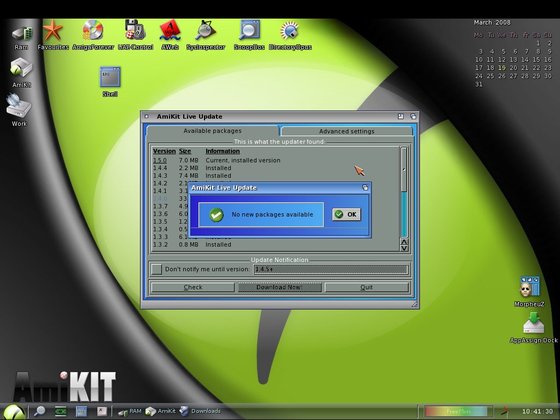Tux meets Amiga, part 2: Porting AmiKit to Linux
Author: Tom Newsom
Published: March 19, 2008
During my article on Amiga emulation on the Linux platform I had deliberately neglected to mention AmiKit as there appeared to be only MS Windows based executable installers and zip archives on the AmiKit web site.
After the article went live, Mike kindly informed us there was indeed a Linux friendly archive of AmiKit. I emailed the AmiKit author, Jan Zahurancik, requesting a link to it as there was no link to be found on the AmiKit web site, only MS centric archives. He duly replied with 3 links, which Jan has requested I do not show here as they were not and are not public versions, to AmiKit in zip and lzx format as well as a link to a PDF file showing how to get AmiKit working on the Linux platform.
I downloaded the zip and lzx files, though I did not use the lzx one at all. I took a cursory glance at the provided PDF file but found it lacking. All it shows is pictures of the MS Window install and goes through the 'guide' picture by picture with very little by way of guidance on actually getting AmiKit to work on the Linux platform. Basically, in my honest opinion the PDF is a waste of time, because if as a Linux user you are looking for a helping hand in getting AmiKit installed the guide will not help you at all because the guide requires an MS Windows system to hand and if you are like me and many other Linux users you will not have one. Plus, it is outdated in places as well. For example it makes mention of the bsdsocket.library and how one should copy this to the Amiga side in the Libs: directory. This of course is no longer required with the latest versions of UAE and E-UAE. If you do need a helping hand then the AmiKit Knowledge base will be of more use as will the AmiKit forums. Be aware though that AmiKit itself is more an MS Windows based thing and just about all its help via the knowledge base and forums is aimed at using AmiKit with WinUAE. However, there are some Linux based nuggets scattered around and even some of the WinUAE bits will guide you. Finally, at the request of Jan I wrote a guide on getting E-UAE and AmiKit working on the Linux platform. That guide can be found here.
I send my thanks to Jan Zahurancik the creator of AmiKit for providing me with the links and for his seemingly bottomless pit full of patience. More on the patience bit later on.
On extracting Amikit140.zip (the filename will invariably change so I cannot give you a direct link. Best I can do is say keep an eye on the download page here, the latest version available at the time of writing), I hit the same problem as I had hit with AIAB in that all the executable bits had been stripped off all Amiga executable files. This appears to be an incompaatibility issue between MS Windows based zip and Linux based zip. The good thing is that because AmiKit uses the directory format fixing this, while not trivial to do properly, was an easy exercise in how to do blanket changes. Forgetting the rights and wrongs of my approach I simply did 'chmod -R u+x *' after doing 'cd /path/to/extracted/amikit/directory/'. A similar approach is to do 'chmod -R 755*' after cd'ing into the extracted directory. It should be fairly trivial to muster up a simple script to look for and act on the executable files as the Linux tool 'file' reports them as 'Amiga OS loadseg()ble executable/binary'.
Whichever method one uses once done it allows E-UAE and AmiKit to boot. After setting up a 'hard drive' which pointed to the directory where I had extracted the AmiKit zip file AmiKit immediately put up a requester asking for 'OS3.9 CD, OS3.5 CD, OS XL CD, Amiga Forever CD and AF installed'. So far so good. AmiKit uses a higher version than Amiga OS3.1 that AIAB and AmigaSYS use. No matter how much I played I could not get AmiKit to see my DVD writer. Rather than fight with this particular issue and as a quick way to get around it I copied the entire Amiga Forever CD onto a directory named Amiga Forever on one of my hard drives and added it as a 'hard drive' to E-UAE. AmiKit then found it and used it to copy various bits and bobs from the Amiga Forever CD into itself. No biggy here either. However, all was not well.
Here is a screen shot to show how it came up:
I do not want to dwell on the problems I encountered because as time went by Jan fixed all of the ones I encountered. But, one problem that was not clear, either to Jan or myself, as to why it happened was an alias on the Amiga side did not and would not 'take'. Think of this as pattern matching, you can imagine what happens on your Linux based system when some pattern matching does not 'take'. The alias in question was XCopy which had a PATTERN attached to it. Because the XCopy PATTERN would not set, several files were not copied from the Amiga Forever CD to the AmiKit install and the AmiKit install itself could not set itself up correctly. Quite a show stopper this one as the files not copied are liberally used throughout the AmiKit install process as well as once AmiKit is up and running.
Being fairly affluent in Amiga DOS scripting, it was a fairly easy task to do these copies manually after reading the S:Startup-sequence which led me to S:Startup-sequence2 script and so on until I had covered every line. Still, this would be a show stopper for most people. Jan created hard-file after hard-file and packed up time and time again the whole shebang that is AmiKit in an effort to get a Linux friendly archive of AmiKit. Unfortunately for both of us Jan was limited in which archiver he could use. Being a MS Windows based man, who incidentally disliked the Redmond created operating system until the day he realised he could run his beloved Amiga within in, Jan was just as determined to get the Linux based install of AmiKit to work correctly as I was.
Throughout this exercise Jan was sat patiently at the other end of an email exchange, which expanded to be an ICQ exchanged after one particularly busy day passing advice back and forth via email was proving too slow a process for Jan who in one email exclaimed "Do you have ICQ?". Fortunately I did. Not everyone has fallen for MS propaganda or Yahoo! prettiness have they I thought as I passed my ICQ number to Jan. With his help and Amiga knowledge and my Amiga guile we eventually got AmiKit up and running via one particular hard-file and an Amiga Forever CD which, as mentioned earlier, was placed on one of my hard drives but still I had to manually copy various files to their proper places. Once this was done AmiKit came up for what was my first proper view of it. And what a thing of beauty it is! I had had my first proper teasing look at AmiKit and I was in awe of what I saw. However, as I was to learn later this thing of beauty on my screen was not in fact correct as Jan knew it should be. Bits where missing off the Workbench desktop for example so who knows what under the hood bits where missing too?
While everything looked nice after sending a screen-shot to Jan of what I assumed was the AmiKit Workbench environment, Jan upon seeing it knew the install process under Linux and E-UAE or UAE still was not perfect.
"Lets have another go." said Jan. Jan also offered up several workarounds in an effort to get the last of the bugs ironed out, but the problem with workarounds is that they are exactly that. Workarounds. Not something your average Joe wants to be doing. Jan sent the link to his latest hard-file which I duly downloaded. Would all Jan's, and my, hard work pay off? Well, yes and no. Still, we was getting ever closer to our goal of a Linux friendly archive.
Using the hard-file that almost worked as a base to work from, Jan sent several 'patches' which had to be copied onto the hard-file. I mounted the hard-file in a loop device using the affs kernel module then copied the 'patch' files across to it. Booted the emulated Amiga and lo and behold! Everything worked perfectly.
Here is a screen shot of E-UAE with AmiKit once booted. Remember at this screen shot stage the work on the Linux based archive was not yet quite complete.
Jan decided to create a zip file whilst inside his WinUAE. He added the word _attrib to the file-name to signify that the attributes that gave us so much trouble would now be no problem. Instead of using the hard-file approach this time Jan plumped for the directory approach. He created this file within the WinUAE/AmiKit environment at his end. This assured the file attributes, when extracted on the Linux platform stayed the same. One additional file called linux_modifications2.zip which was to fix some differences between WinUAE and E-UAE was created, applied and the install began. It worked 100%. Jan was happy to have a working Linux port of AmiKit and I was happy to be his beta tester offering a helping hand here and there.
Once AmiKit had finished installing the, in my case, Amiga Forever files, it asked to "Press ENTER to reboot". Once rebooted E-UAE and AmiKit presented themselves and what a thing of absolute beauty it is. The wealth of programs available within AmiKit is simply overwhelming in that there are literally hundreds to play with from simple editors to comprehensive word processors, games, tons of utilities for every use imaginable. The list of programs included in AmiKit is quite simply overwhelming.
The Linux platform now has a fully working AmiKit140 archive.
So, now that AmiKit works on Linux what does AmiKit offer AmigaSYS and AIAB (see part 1 for explanations of these) do not? The answer to that is lots! AmiKit has over 300 programs within it. It is pure fun and enjoyment working ones way around the AmiKit powered Workbench.
For a start AmiKit leverages the changes and additions Amiga OS 3.5/3.9 offer over Amiga OS3.1. There is a way to use Amiga OS3.1 but if one does use that version they will find they miss out of a few of the better things within AmiKit that rely on the later Workbench suites. There are a few Amiga applications written purely for AmiKit. LiveUpdate, of which Jan is particularly proud, MorpheuZ for changing Themes, window manager and such like. It also has a special only available to AmiKit Dopus5 the ubiquitous file manager turned Workbench replacement. Dopus5 itself requires a fair amount of grunt to operate correctly and so AmiKit leverages P96 (Picasso the graphics driver program) to full effect. In addition to those mentioned Jan has bagged himself some AmiKit specials. These are special versions of some programs that no-one else has. Jan, apparently, got these by asking the authors and filing lots of bug reports etc. As well as these special AmiKit only programs there are over 300 other freely available programs included with AmiKit. Far too many for me to list them all in this article but be assured every one is useful in one way or another to someone. On the whole they are all bonded together with some Amiga DOS, Arexx and Dopus5 scripting mostly created by Jan himself.
Browsing the Web:
To find out a little more about Jan, his ambitions for AmiKit and generally a good read take a look at this interview Jan gave with The Crypt Magazine.
Finally I have a screen-shot for you that if you are a one time long since gone but never forgotten Amiga user or someone whose interest has been peeked by this article it sure to blow your mind. Even in this day and age that old dog Amiga surely stands the test of time. Take a look, be prepared to be amazed.
Well, not quite. One stubborn problem, while not vital to normal operation of AmiKit as it can be done manually (details of how are on the AmiKit web site here), was that LiveUpdate, a program developed for AmiKit to automate the process of keeping AmiKit up to date with new versions of applications as and when released, refused to work as advertised. Jan put me in touch with the LiveUpdate's author and after a few test versions and release candidates he arrived at a version that did work as advertised, well there was a lot more to it than that but it will be tedious reading.
What was the problem? Well, LiveUpdate's author (a certain Mr Daniel Westerberg (who's personal web site is here and his business web site is there) writes the program on a real Amiga which has a real TCP stack unlike UAE and E-UAE which have an emulated TCP stack. Both the emulated TCP stack and the real TCP stack use a library called bsdsocket.library but UAE and E-UAE implementation is not complete and so LiveUpdate hit upon the part that is not complete which stopped his program from functioning fully. As I said, after a few revisions this particular, and the only bug left, was squashed and now LiveUpdate works as it should which makes using AmiKit all the more pleasurable. Daniel is somewhat typical of an Amiga user in that he is very friendly and gives his time and programs for free for all to use.
LiveUpdate in action:
Will I use AmiKit in preference to AmigaSYS my previous favourite Workbech environment? A resounding yes. The screen shots do not show just how much work Jan has put into creating his emulated Amiga Workbench nor the extra work Jan put in to get a fully working Linux based archive. But lots of work, and no doubt love, have gone into AmiKit and it shows. Its beauty needs to be seen to be believed! It is truly a labour of love, a work of art even. Give E-UAE and AmiKit a try and decide for yourself. I feel sure that you will come to the same conclusion as I have and that is that AmiKit is wonderful and a joy to use.
For anyone who is, or was, an Amiga user I urge you to give AmiKit a run. For those of you reading about the Amiga emulated environment for the first time should also give E-UAE and AmiKit a go. Combined with E-UAE AmiKit is a sight to behold and a pleasure to use. You can download the zip archive of AmiKit for Linux from here. With a guide to getting it all to work, written by yours truly, here. To get E-UAE, which seems to me to be the future of Amiga emulation on the Linux platform, sure it is missing several features compared to WinUAE, but it is sure to mature as time progresses and as it uses the WinUAE core you can be sure of its excellence. To get E-UAE, go here or if you prefer an alternative version try Bernd Schmidt's original UAE from here.
Of AmiKit itself I can but parrot Yoda who if he had seen and used it may have said.
<Yoda>Impressed I am. Use E-UAE and AmiKit I will.</Yoda>
Finally, a quick word about Amiga ROM files and Workbench disk sets.
I, like any true free, free as in free speech, not as in free beer, thinking individual abhors piracy. Vendor lock in is also something I do not like but, as with the nVidia graphics driver and 4Fronts OSS sound driver package, both of which I use because of their superiority over GPL governed alternatives for my particular hardware, sometimes one has to forgo ones principles, bite the bullet so to speak and use them.
Because I refuse to pirate anything and because of my liking for all things Amiga I needed a way to get the ROM and Workbench disk set into a format suitable for UAE and E-UAE usage. Prior to purchasing Amiga Forever the method of getting the ROM and Workbench disk sets I used involved the usage of GrabKick on my still owned Amiga 1200, to get a ROM image, and one or more of the ADF utilities, freely available on Aminet, to convert the Workbench floppy disk set into ADF format.
Sure this method is a royal pain but the mere thought of pirating these files, which are available from several places on the Internet, makes me cringe.
Simply stated. Do Not Pirate These Files!
AmiKit itself does not come with either the needed ROM files nor any Workbench disks out of the box. Nor do UAE or E-UAE for that matter. The reason none of these include these needed files is due to copyright. Incidentally, it is this same copyright issue that forces AmiKit and such like program sets to request the disks so they can copy some files off the disk into their environment so that they can function stand alone. For AmiKit, I think this is a shame as AmiKit is by far the most complete of its ilk which includes such names as ClassicWB, Amiga-In-A-Box, AmigaSYS and possibly others I do not know about.
If you know of any complete Workbench environments, free or none free, not mentioned in this article or the previous one then please email us at Slackworld [gmail.com] and let us know because if there is to be a 3rd article in this series, it will be about comparing them all side by side.
In the murky waters that is the ownership of the Amiga Workbench and ROM arena I lost track a long time as to who owns what now, but I seem to remember Cloanto got the redistribution rights which may or may not have included selling on the Amiga ROM and Workbench sets to third parties. They are and do distribute them themselves as part of their Amiga Forever distribution, so, if you want a legally purchased set then go here and purchase Amiga Forever which includes them.
Breaking News!
It would appear I spoke to soon. Just before this article was submitted to Slackworld Jan told me that AmiKit will be available as an optional package for Amiga Forever 2008 which can be easily installed via Amiga Forever's internal mechanism. AmiKit itself will never be commercial. Jan is adament about that. Amiga Forever 2006 is available for purchasing right now and anyone who does buy it now will be eligible for a free upgrade to 2008 when it is released, which is anytime now. This news nugget (you probably heard it here first) proves that AmiKit really is the best all round Amiga Workbench environment.
Address of this article: http://slackworld.berlios.de/2008/amikit.html

